Abrasion And Polishing
Question 1. Write a short note on polishing agents.
Answer:
It is a production of a smooth mirror-like surface without much loss of any external form.
Types of Polishing:
- Abrasive
- Nonabrasive.
Read And Learn More: Dental Materials Question And Answers
- Abrasive Polishing: If the particle size of an abrasive is reduced sufficiently, the surfaces become, extremely fie and may disappear entirely. The surface then acquires a smooth shiny layer known as a polish. The polishing agent removes material from the surface molecule by molecule. The microcrystalline layer is referred to as the polish layer or “Beilby layer”
-
-
- Polishing Agents:
-
-
Polishing agents Physical characteristics Chemical characteristics Used on Chalk It is a white abrasive - It is a mineral obtained from calcite
- This is composed of calcium carbonate
- Amalgam
- Enamel
- Gold foil
- Plastic material
Pumice This is light grey in color This is a siliceous material obtained from volcanic activity Amalgam Acrylic resin Gold foil Tripoli - This is light in weight and is friable.
- It is available in white, grey, pink, red, and yellow colors.
- This is ground to fine particles
– Acrylic resin Metal alloy Rouge Iron oxide is a fine red abrasive and is a component of rouge – High noble metal alloys Tin oxide It is an extremely fine abrasive – On teeth and metallic restorations
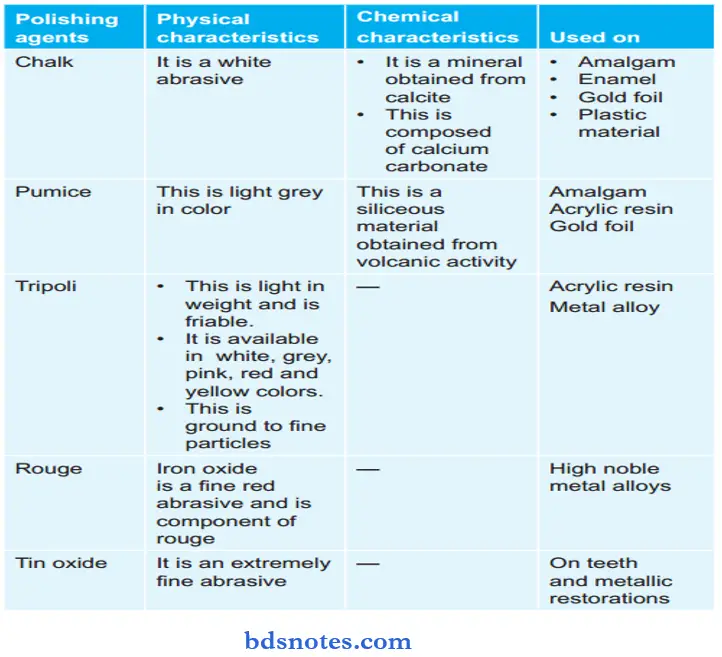
Nonabrasive Polishing These include:
- Composite glazing: A layer of glaze or glass (a clear transparent liquid made of unfiled resin) is applied over the restoration and cured. This results in a smooth highly glossy surface.
- Glazing ceramics: The finished restoration is subjected to high temperature. At this temperature, the surface layer melts and flows to produce a smooth glass-like surface.
- Electrolytic polishing: In electrolytic polishing, the material is removed through an electrochemical process.
- Burnishing: It is related to polishing in that the surface is drawn or moved. Instead of using many tiny particles, only one large point is used.
Question 2. Write a short note on abrasives and polishing agents.
Or
Answer briefly on denture finishing materials (Abrasive and polishing agents).
Or
Write a brief on abrasive and polishing agents.
Or
Write a short note on abrasives.
Or
Write in brief on abrasives and polishing agents.
Or
Describe a brief abrasive used in dentistry.
Or
Write in detail about finishing and polishing agents.
Or
Write a short note on abrasive and polishing agents used in dentistry.
Answer:
Abrasion: It occurs when a hard rough surface slides along a softer surface and cuts a series of grooves. The wearing away of a substance or a structure through a mechanical process such as grinding, rubbing, or scraping.
Polishing: It is the production of a smooth mirror-like surface without much loss of an external form. If the particle size of the abrasive is reduced sufficiently the scratches become extremely fie and may disappear entirely. The surface then acquires a smooth shiny layer known as polish.
Abrasive And Polishing Agents:
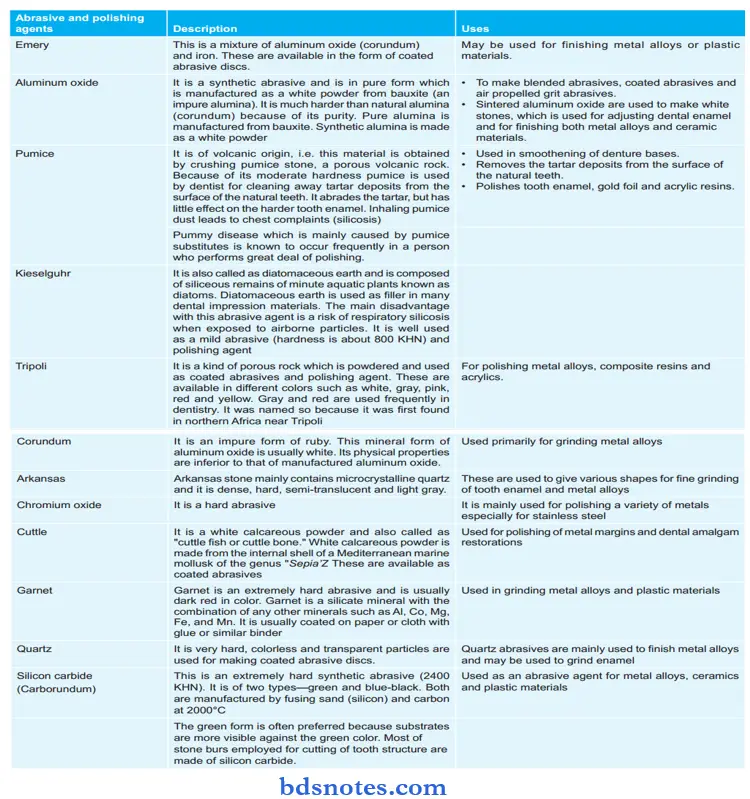
Question 3. What do you understand by the words abrasive and polishing agents? How and what are the agents used in polishing in gold restorations?
Answer:
Agents used in Polishing Gold Restorations: Gold is relatively a soft material. Therefore, it requires a different approach than that used for other metals used in dentistry. Slow-speed handpiece should be used in finishing and polishing gold alloy.
The technique consists of the following steps:
- Contour with carbide burs, heatless stone, or green stone (silicate carbide).
- Finishing with pink stone (aluminum oxide) or medium grade abrasive impregnated rubber wheels and points (brown and green).
- The final finish is done by applying fine abrasive-impregnated rubber wheels, cups, and points.
- Polishing is done by applying tripoli or rouge with rag or leather wheels.
Question 4. Write a short note on the types and composition of dentifrices.
Or
Write short notes on dentifrices.
Answer:
Dentifrices: These are the agents used with a toothbrush to clean and polish natural teeth. They should have maximum cleansing efficiency with minimum tooth abrasive. Popularly dentifrices are known as toothpastes.
Types Of Dentifrices. They are classified based on their primary function:
- Caries prevention and treatment:
- Fluoride concentration up to 1,000 ppm
- Fluoride concentrations from 1,000 to 2000 ppm
- Fluoride concentration from 2,500 to 5,000 ppm.
- Periodontal disease prevention and treatment:
- Natural antibacterial and antiseptic agents
- Synthetic antibacterial and antiseptic agents.
- Desensitizing pastes:
- Analgesic
- Dentin tubules blocking.
- Whitening pastes:
- Abrasive
- Bleaching.
- Pastes for specific purposes:
- Toothpaste for xerostomia (for example, olive oil, betadine, and xylitol)
- Antiviral pastes (for example,larifan for herpetic infection or aphthae).
Composition Of Dentifrices:
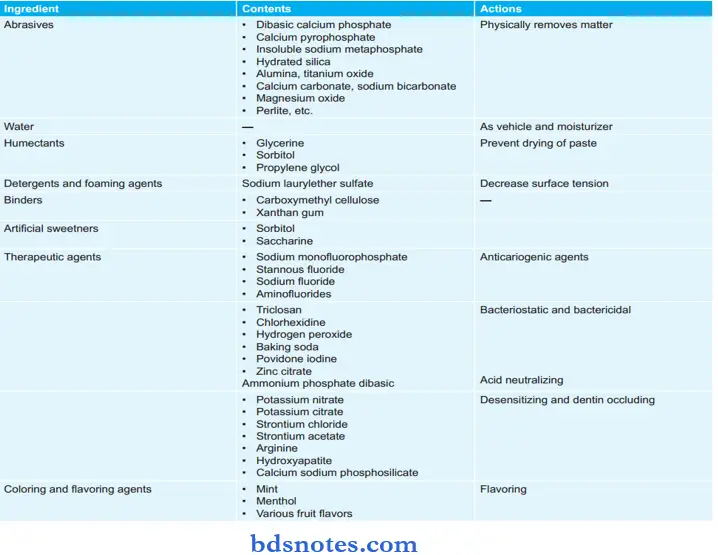
Function Of Dentifrices:
- It assists the toothbrush in removing stains, debris, and soft deposits from teeth.
- It imparts polishing to the surface of the tooth.
Question 5. Write a short note on the rake angle.
Answer:
Each bur blade has two sides, the rake face and clearance face, and three angles, rake angle, edge angle, and clearance angle.
- The rake angle is the most important design characteristic of a burred blade.
- The rake angle is the angle between the rake face and the radial line.
- The rake angle depends on such factors as the mechanical properties of the blade material, the mechanical properties of the material being cut, the rotational speed and diameter of the bur, and the lateral force applied by the operator.
Types of Rake Angle:
- Positive rake angle: When the rake face trails the radial line.
- Negative rake angle: When the rake face is ahead of the radial line.
- Zero rake angle: When the rake face and radial line coincide with each other.
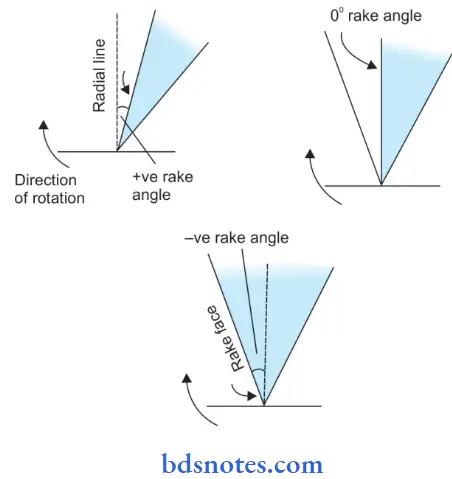
Question 6. Write a short note on abrasive and polishing units.
Answer:
Following are the Abrasive and Polishing Units:
- Finishing burs: Burs are made of stainless steel or tungsten carbide. 12–40 fluted carbide burs are usually recommended for finishing depending upon the restorative material. Plain burs are also used before final polishing.
- Diamond instruments and pastes: It is considered a super abrasive because it is the hardest material known and is capable of abrading almost any other material. It is available commercially in the form of bonded abrasive rotary instruments, metal-backed abrasive strips, and polishing pastes.
- Finishing diamonds of medium-fie grit contain diamond particles of 840 µm in diameter. They should always be used with a light force and copious water spray to preserve the very fie diamond coatings. Diamond polishing pastes are also available with particle sizes ranging from 2–5 µm. Diamond abrasives are preferably used on ceramic and composite materials.
- Brushes: Brushes can be used either alone or in combination with abrasive particles. Most of the brushes have synthetic bristles, others may have wire bristles for polishing cast restorations.
- Cloth: Cloth carried on a metal wheel may be used for final polishing with/without a polishing medium.
- Felt: Felt is used to attain luster for the metallic restorations usually with a polishing agent. It is available in different shapes of wheels, cones, and cylinders.
- Rotary rubber instruments:
- Rubber-ended rotary tools are commonly used for polishing procedures.
- They can be obtained in various shapes of cups, wheels, cones, etc., and are commonly used with other abrasives or polishing pastes.
- Coated discs and strips:
- The abrasive particles such as sand, cute, garnet, boron carbide, silicon carbide, etc. are held onto a flexible heavy-weight paper or mylar strips with a suitable adhesive material.
- The discs may be attached to a mandrel for rotary finishing. Abrasive strips are used by hand in a back-and-forth motion, especially for finishing proximal areas.
Question 7. Write a short note on medicated dentifrices.
Answer:
Medicated Dentifrices: Certain medications are added to the toothpastes and toothpowders so as to empower them with prophylactic/ therapeutic activity against specific dental conditions.
These are:
- Fluoride: Sodium monofluorophosphate or sodium fluoride or caries prevention. Most toothpastes contain a fluoride.
- Antiseptics: Chlorhexidine, triclosan, or benzalkonium chloride for prevention and treatment of dental plaque. A copolymer is often included with triclosan to prolong its substantivity.
- Desensitizing agents: Potassium nitrate or strontium chloride are mostly added to treat dentine sensitivity.
- Bleaching agents: Carbamide peroxide is the most common bleaching agent added to stain-removing dentifrices
Question 8. Write a short note on rouge.
Answer:
Rouge is an iron oxide inline form. Mohs scale: 5–6.
- It is blended with various soft binders into a cake or bar form.
- When impregnated in cloth it is called crocus cloth.
- It is used to polish high-noble metal alloys
- Rouge is contraindicated for polishing stainless steel and cobalt-chromium alloys as iron contaminates the surface and facilitates corrosion.
- It is used as a coloring agent in impression compounds.
- Rouge is mixed with chloroform and is used as antireflux.
Question 9. Write in brief on dental our design.
Answer:
Dental Bur is a small milling cutter.
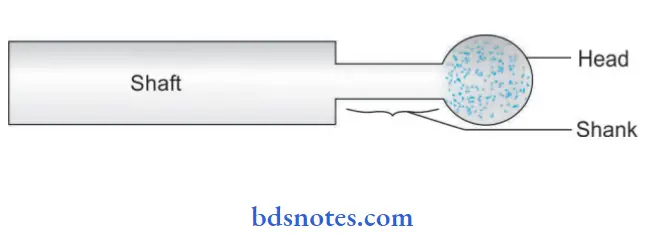
A dental bur has three parts head, shank, and shaft.
- Head: Portion carrying the cutting blades.
- Shank: Portion connecting the head to the shaft.
- Shaft: Portion which will be engaged within the handpiece.
Design of dental bur:
- Blade or cutting edge: It is in contact with the horizontal line of work.
- Tooth face: Sides of tooth ahead of cutting edge in the direction of rotation.
- Back or flank of the tooth: The opposite side of the face.
- Rake angle: The face of the bur tooth is at an angle to the radial line from the center of the cutting edge.
- Negative rake angle: If the face is ahead and leading the radial line in reference to the direction of rotation, the angle formed between the face and radial line is
called negative rake angle. - Zero or radial rake angle: if the face is on the radial line the rake angle is zero.
- Positive rake angle: When the radial line leads the face so that the rake angle is on the inside of the radial line.
- Negative rake angle: If the face is ahead and leading the radial line in reference to the direction of rotation, the angle formed between the face and radial line is
- Clearance angle:
- The angle between the back of the tooth and the work is known as the clearance angle.
- The angle between the land and the work is called the primary clearance angle and the angle between the back and the work is known as the secondary clearance angle.
- Land: The plane surface immediately follows the cutting edge.
- Tooth angle: It is the measurement between the face and the back or between the face and land.
- Flute or chip space: This is the space between successive teeth.
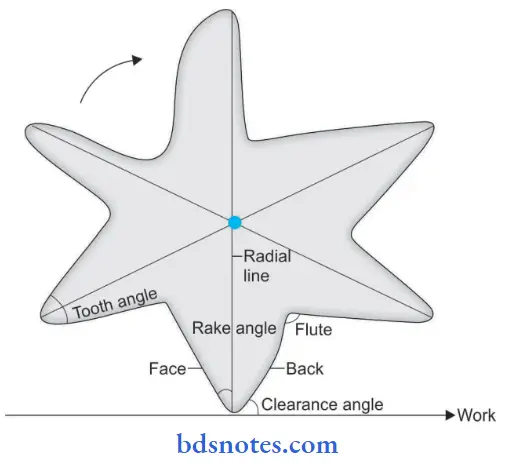

Leave a Reply